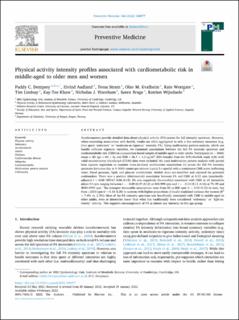Physical activity intensity profiles associated with cardiometabolic risk in middle-aged to older men and women
Dempsey, Paddy C.; Aadland, Eivind; Strain, Tessa; Kvalheim, Olav Martin; Westgate, Kate; Lindsay, Tim; Khaw, Kay-Tee; Wareham, Nicholas J.; Brage, Søren Karl; Wijndaele, Katrien
Peer reviewed, Journal article
Published version
Permanent lenke
https://hdl.handle.net/11250/3022460Utgivelsesdato
2022Metadata
Vis full innførselSamlinger
- Import fra CRIStin [3604]
- Institutt for idrett, kosthald og naturfag [1006]
Originalversjon
Dempsey, P. C., Aadland, E., Strain, T., Kvalheim, O. M., Westgate, K., Lindsay, T., Khaw, K.-T., Wareham, N. J., Brage, S., & Wijndaele, K. (2022). Physical activity intensity profiles associated with cardiometabolic risk in middle-aged to older men and women. Preventive Medicine, 156:106977. 10.1016/j.ypmed.2022.106977Sammendrag
Accelerometers provide detailed data about physical activity (PA) across the full intensity spectrum. However, when examining associations with health, results are often aggregated to only a few summary measures [e.g. time spent “sedentary” or “moderate-to-vigorous” intensity PA]. Using multivariate pattern analysis, which can handle collinear exposure variables, we examined associations between the full PA intensity spectrum and cardiometabolic risk (CMR) in a population-based sample of middle-aged to older adults. Participants (n = 3660; mean ± SD age = 69 ± 8y and BMI = 26.7 ± 4.2 kg/m2; 55% female) from the EPIC-Norfolk study (UK) with valid accelerometry (ActiGraph-GT1M) data were included. We used multivariate pattern analysis with partial least squares regression to examine cross-sectional multivariate associations (r) across the full PA intensity spectrum [minutes/day at 0–5000 counts-per-minute (cpm); 5 s epoch] with a continuous CMR score (reflecting waist, blood pressure, lipid, and glucose metabolism). Models were sex-stratified and adjusted for potential confounders. There was a positive (detrimental) association between PA and CMR at 0-12 cpm (maximally-adjusted r = 0.08 (95%CI 0.06–0.10). PA was negatively (favourably) associated with CMR at all intensities above 13 cpm ranging between r = −0.09 (0.07–0.12) at 800-999 cpm and r = −0.14 (0.11–0.16) at 75–99 and 4000-4999 cpm. The strongest favourable associations were from 50 to 800 cpm (r = 0.10–0.12) in men, but from ≥2500 cpm (r = 0.18–0.20) in women; with higher proportions of model explained variance for women (R2 = 7.4% vs. 2.3%). Most of the PA intensity spectrum was beneficially associated with CMR in middle-aged to older adults, even at intensities lower than what has traditionally been considered “sedentary” or “light-intensity” activity. This supports encouragement of PA at almost any intensity in this age-group.

